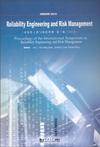可靠性工程与风险管理·第2辑/2010
2010-8
同济大学出版社
李杰 编
1037
Reliability engineering and risk management is a crossed frontier research of probabilistic mechanics and engineering disciplines, which has gained increasing attention in the past ten years, and is of growing significance in civil, mechanical, aerospace and aeronautics, offshore and marine engineering, as well as in many other disciplines of engineering. This research provides effective methodologies for reducing the risk of engineering and promoting the sustainability of development of human society. Within this background and a perspective of recent rapid progresses in society and economy in China, an International Workshop on Reliability Engineering and Risk Management (IWRERM 2008) was successfully held by Tong ji University and Nagoya Institute of Technology in Shanghai on August 21——23, 2008. Around 30 distinguished scholars from 8 countries were invited to attend the workshop. The participants made active and deep discussions on the focused themes of that workshop. Some wide consensuses were reached, one of which is that an International Symposium on Reliability Engineering and Risk Management in the wider range should be held in 2010. Having this background, the International Symposium on Reliability Engineering and Risk Management (ISRERM 2010) was organized and held on September 23——26, 2010 at Tong ji University in Shanghai China. This symposium is co-organized by Tong ji University, Kanagawa University and the International Association of Structural Safety and Reliability (IASSAR), and is jointly sponsored by the academic societies including IABMAS, IALCCE, ASCE, AIJ, JSCE, CCES, ASC, CSVE, KSCE, NSFC and the State Key Laboratory of Disaster Reduction in Civil Engineering in Tong ji University. It aims to bring engineers and scientists all over the world together to present and discuss innovative methodologies and practical applications of these technologies in the field of reliability engineering and risk management. A number of 150 invited participants from 23 countries attended the symposium and conducted fruitful discussions and communications. Included in the present book are the Kwang hua Lecture, Keynote Lectures and Collected Lectures, totally 135 papers. These papers cover the topics involving hazard risk assessment and management, structural control and damage diagnosis, structural reliability methods, construction engineering and design methods, and probabilistic structural mechanics., We are grateful to the contributions from the participants and authors who make this symposium successful.
本书是2010年9月23—26日在同济大学举行的International Symposium on ReliabilityEngineering and Risk Management(ISRERM 2010)的会议论文集,作者均为可靠性工程与风险管理领域的国际一流学者,包括国际结构安全性与可靠性协会(IASSAR)和结构安全性联合委员会(JCSS)等重要学术组织的核心成员,多位中国科学院、美国工程院和欧洲科学院院士,以及活跃在国际学术界的中青年研究学者。该书反映了近年来国际上可靠性工程与风险管理方面的现状与最新进展。 本书可供土木、机械、航空航天和海洋工程等专业的教师、研究人员、研究生和高年级大学生阅读。
PrefaceKwang-Hua LectureKeynote Lectures and Invited LecturesHazard Risk Assessment and ManagemetnStructural Control and Damage DiagnosisStructural Reliability MethodsConstruction Engineering and Design MethodsProbabilistic Structural Mechanics
Real-time hybrid simulation, also known as real-time substructure testing, is a new experimental technique for investigating the dynamic response of structural systems subject to external excitation (Blakeboroughet al, 2001 ; Chen et al., 2009a). It divides a structural system into experimental substructure(s) and analytical substructure(s), where the experimental substructures are physically tested in the laboratory and the numerical substructures are analytically modeled by a finite element program. An integration algorithm is often used to solve the structural dynamics based on the restoring forces of the substructures and to generate the commands. It is therefore widely accepted by the research community that the real-time hybrid simulation can realistically replicate the response of building structures subjected to earthquakes (NSF Chicago Work shop, 2007). Real-time hybrid simulation has been attracted considerable attention and used by researchers for structural engineering research (Christenson, 2008; Chen et al., 2009b). Since the exact solution of the response of the prototype structure under earthquake most often is not available for researchers, the questions rises that how reliable is the real-time hybrid simulation results, i.e., how probably does the real-time hybrid simulation accurately predict the structure An accurate and reliable real-time hybrid simulation requires that the boundary condition of the experimental substructures be correctly simulated throughout the simulations the analytical substructure be accurately modeled by the finite element program; the integration algorithm should accurately solve the structural dynamics of the prototype structure; and the servo-hydraulic actuators apply the commands accurately onto the experimental substructures. These pose challenges for reliability assessment of a real time hybrid simulation. In this paper, the reliability analysis of real-time hybrid simulation is focused on the error due to actuator control. During a real-time hybrid simulation, the compatibility and equilibrium at the interface between the substructures is often fulfilled by servo-hydraulic actuators, which are expected to apply the command displacements to the experimental substructures and feed back the measured restoring forces in a timely manner. However, due to inherent servo-hydraulic dynamics, a hydraulic actuator has an inevitable delay in response to the command. This time delay, often referred to as actuator delay, will result in an actuator control error that is inevitable. The studies on the effect of actuator delay on real-time testing show that actuator delay will destabilize a real-time test if not compensated properly (Wallace, et al., 2005; Chen and Ricles, 2007). To negate effect of actuator delay, different compensation methods have been developed by structural engineering researchers (Horiuchi et al., 1999, 2001; Jungand Shing, 2006; Chen, 2007). Chen and Ricles (2009a) show that the performance of a compensation method for constant delay can be analyzed through the frequency response analysis of the equivalent discrete transfer function. More recently compensation methods based on adaptive control theory were developed (Bonnet et al., 2007; Chen and Ricles,2009b). These compensation methods have been experimentally demonstrated to be effective for minimizing the effect of variable actuator delay during a real time hybrid simulation. However, due to the high nonlinearity in the servo-hydraulic system and the experimental substructure, it is difficult, often impossible, to attain perfect actuator control and eliminate actuator control error for a real-time hybrid simulation. This brings research needs for reliability analysis of real-time hybrid simulation results with the presence of actuator control error. The purport of this paper is to discuss some currently existing variables for possible reliability assessment of real-time hybrid simulation results.
